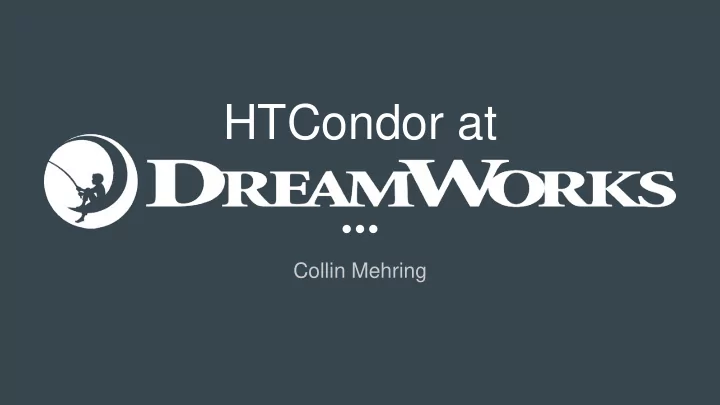

HTCondor at Collin Mehring
Using HTCondor Since 2011
Animation Studio Background ● Productions are our customers ○ Artists are the end users ● Production stages and their teams ○ Layout -> Animation -> Lighting / FX -> Finaling ● The production hierarchy - Production -> Sequence -> Shot -> Frames ○ Frames are composed of many steps composited together ○ Each frame has a left- and right-eye version for 3D effect ○ ~260k frames in a movie ● Support many different applications ● Hard deadlines ○ Leads to large amounts of work during crunch time
Who interacts with HTCondor and how? ● Artists ○ Submit to the farm and expect frames back ○ Focus on the art, no technical knowledge of HTCondor required ● Technical Directors ○ Configure artists’ software to use submission tools ○ Debug issues on the shot setup side ● TRAs (Technical Resource Admins / Render Wranglers) ○ Mange the HTCondor farm jobs Answer artists’ questions about the farm, and provide help ○ ● JoSE (Job Submission and Execution, R&D team) ○ Configure HTCondor ○ Develop and maintain tools to help the TRAs manage the farm ○ Developing submission tools
Why do we configure HTCondor the way we do? ● End users shouldn’t require any technical knowledge of the scheduling system ○ Available settings should be things they care about, everything else is automatic ● The scheduling system should not noticeably impact the end users ● Admins should be able to easily manage large amounts of jobs ● Admins should have easy access to all relevant information and statistics ○ Easier troubleshooting, helps establish causation, and present information to productions ● Prioritize throughput, but consider turnaround time as well ○ Minimize wasted compute hours ○ New renderer scales very well with cores, prioritize scheduling large jobs ● Accounting groups should always get their minimum allocation ● Help productions meet deadlines anyway possible
How do we have HTCondor configured? ● All DAG jobs Quick Facts ○ Many steps involved in rendering a frame ● GroupId.NodeId.JobId instead of ClusterId ● Central Manager and backup (HA) ○ Easier communication between departments ○ On separate physical servers ● No preemption (yet) ● One Schedd per show, scaling up to ten ○ Deadlines are important - No lost work ○ Split across two physical servers ○ Checkpointing coming soon in new renderer ● About 1400 execution hosts ● Heavy use of group accounting ○ ~45k server cores, ~15k desktop cores ○ Render Units (RU), the scaled core-hour ○ Almost all partitionable slots ○ Productions pay for their share of the farm ● Complete an average of 160k jobs daily ● Execution host configuration profiles ● An average frame takes 1200 core hours ○ e.g. Desktops only run jobs at night over its lifecycle ○ Easy deployment and profile switching ● Trolls took ~60 million core-hours ● Load data from JobLog/Spool files into Postgres, Influx, and analytics databases
What additional configuration have we added? ● Lots of additional ClassAd attributes (~50) ● Concurrency limits ○ Each group has their own limit ○ Software limits can be per host, and can be released early ● Error & Production Error status ○ Differentiating between held and errored jobs ● Subway - Python submission API ○ In terms of studio specific constructs ○ Deferred submissions, v4 provides a REST API ● Job Policy ○ Predefined templates of several job attributes ● Heavy use of pre- and post-priorities
How do we manage our HTCondor pool? The Farm Manager (WebApp) ● ● Filter your view GUI for managing the HTCondor pool ○ ○ Only see the groups relevant to you Used by TRAs, TDs, Artists, etc. ● ● Hides most low-level HTCondor data See specific details ○ ○ ClassAds, DAGs, SDFs, etc. Group progress ● ○ Allocate resources between shares Job stats and information ■ ○ Logs, charts, etc. Separate allocations for day and night ○ ● Finished and Canceled jobs Monitor execution hosts ● Perform actions on jobs ○ Data and charts, just like jobs ○ ● Supports batched actions on nodes & Links to other monitoring tools groups ○ Can modify jobs that haven’t been submitted yet by the DAG
How do we monitor pool stats in real-time? Grafana ● Primarily used by the TRAs / Render Wranglers ● Quickly detect issues and receive alerts ● At-a-glance overview of the render farm ● Diagnose problems ○ Correlate events between metrics ● More dashboards for specific use cases ○ Software license usage, HTCondor negotiator stats, etc.
Viewing Historical Data Tableau ● Big Picture ○ Trends over time ○ Comparison between productions ● Used primarily for scheduling ○ Can we fit all of the rendering we’re planning on doing into the render farm concurrently? ○ How do we move things around to make it all fit? ○ Are there areas we can optimize to better use the existing farm resources? ○ Are we still on schedule? ● Historical data stored in a separate database
RU Per Frame ● Shows historically how much compute is being used for each sequence ● Tracks overall trends and identifies complex sequences ● Userful for scheduling production work, allocating resources between teams
Sequence-Shot Details ● Shows RU usage for every farm job, broken down by sequence and shot ● Useful for identifying outliers and specific issues
Overnight Rendering Summary ● Tracks nightly render farm performance ● Number of jobs submitted by each production ○ Grouped by priority, with percent completed ● Amount of RU used by each production compared to their allocations, broken down by team ● Total RU used compared to capacity, broken down by production ● Proportion of capacity allocated to each production compared to what they actually used ● Memory usage compared to capacity
Question Time
Recommend
More recommend